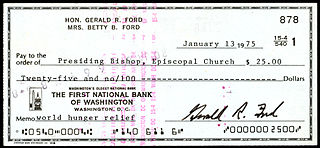Related Research Articles

A cheque or check is a document that orders a bank to pay a specific amount of money from a person's account to the person in whose name the cheque has been issued. The person writing the cheque, known as the drawer, has a transaction banking account where the money is held. The drawer writes various details including the monetary amount, date, and a payee on the cheque, and signs it, ordering their bank, known as the drawee, to pay the amount of money stated to the payee.
A direct debit or direct withdrawal is a financial transaction in which one organisation withdraws funds from a payer's bank account. Formally, the organisation that calls for the funds instructs their bank to collect an amount directly from another's bank account designated by the payer and pay those funds into a bank account designated by the payee. Before the payer's banker will allow the transaction to take place, the payer must have advised the bank that they have authorized the payee to directly draw the funds. It is also called pre-authorized debit (PAD) or pre-authorized payment (PAP). After the authorities are set up, the direct debit transactions are usually processed electronically.
A chargeback is a return of money to a payer of a transaction, especially a credit card transaction. Most commonly the payer is a consumer. The chargeback reverses a money transfer from the consumer's bank account, line of credit, or credit card. The chargeback is ordered by the bank that issued the consumer's payment card. In the distribution industry, a chargeback occurs when the supplier sells a product at a higher price to the distributor than the price they have set with the end user. The distributor submits a chargeback to the supplier so they can recover the money lost in the transaction.

An overdraft occurs when something is withdrawn in excess of what is in a current account. For financial systems, this can be funds in a bank account. In these situations the account is said to be "overdrawn". In the economic system, if there is a prior agreement with the account provider for an overdraft, and the amount overdrawn is within the authorized overdraft limit, then interest is normally charged at the agreed rate. If the negative balance exceeds the agreed terms, then additional fees may be charged and higher interest rates may apply.
A merchant account is a type of bank account that allows businesses to accept payments in multiple ways, typically debit or credit cards. A merchant account is established under an agreement between an acceptor and a merchant acquiring bank for the settlement of payment card transactions. In some cases a payment processor, independent sales organization (ISO), or member service provider (MSP) is also a party to the merchant agreement. Whether a merchant enters into a merchant agreement directly with an acquiring bank or through an aggregator, the agreement contractually binds the merchant to obey the operating regulations established by the card associations. A high-risk merchant account is a business account or merchant account that allows the business to accept online payments though they are considered to be of high-risk nature by the banks and credit card processors. The industries that possess this account are adult industry, travel, Forex trading business, multilevel marketing business. "High-Risk" is the term that is used by the acquiring banks to signify industries or merchants that are involved with the higher financial risk.

Payment cards are part of a payment system issued by financial institutions, such as a bank, to a customer that enables its owner to access the funds in the customer's designated bank accounts, or through a credit account and make payments by electronic transfer with a payment terminal and access automated teller machines (ATMs). Such cards are known by a variety of names, including bank cards, ATM cards, client cards, key cards or cash cards.
An acquiring bank is a bank or financial institution that processes credit or debit card payments on behalf of a merchant. The acquirer allows merchants to accept credit card payments from the card-issuing banks within a card association, such as Visa, MasterCard, Discover, China UnionPay, American Express.

An ATM card is a dedicated payment card card issued by a financial institution which enables a customer to access their financial accounts via its and others' automated teller machines (ATMs) and, in some countries, to make approved point of purchase retail transactions. ATM cards are not credit cards or debit cards, however most credit and debit cards can also act as ATM cards and that is the most common way that banks issue cards since the 2010s.

Chargeback insurance is an insurance product that protects a merchant who accepts credit cards. The insurance protects the merchant against fraud in a transaction where the use of the credit card was unauthorized, and covers claims arising out of the merchant's liability to the service bank.
A controlled payment number, disposable credit card or virtual credit card is an alias for a credit card number, with a limited number of transactions, and an expiration date between two and twelve months from the issue date. This "alias" number is indistinguishable from an ordinary credit card number, and the user's actual credit card number is never revealed to the merchant.
Internet fraud prevention is the act of stopping various types of internet fraud. Due to the many different ways of committing fraud over the Internet, such as stolen credit cards, identity theft, phishing, and chargebacks, users of the Internet, including online merchants, financial institutions and consumers who make online purchases, must make sure to avoid or minimize the risk of falling prey to such scams.

Credit card fraud is an inclusive term for fraud committed using a payment card, such as a credit card or debit card. The purpose may be to obtain goods or services or to make payment to another account, which is controlled by a criminal. The Payment Card Industry Data Security Standard is the data security standard created to help financial institutions process card payments securely and reduce card fraud.
An issuing bank is a bank that offers card association branded payment cards directly to consumers, such as credit cards, debit cards, contactless devices such as key fobs as well as prepaid cards. The name is derived from the practice of issuing cards to a consumer.

A credit card is a payment card, usually issued by a bank, allowing its users to purchase goods or services or withdraw cash on credit. Using the card thus accrues debt that has to be repaid later. Credit cards are one of the most widely used forms of payment across the world.
A payment processor is a system that enables financial transactions, commonly employed by a merchant, to handle transactions with customers from various channels such as credit cards and debit cards or bank accounts. They are usually broken down into two types: front-end and back-end.
Card schemes are payment networks linked to payment cards, such as debit or credit cards, of which a bank or any other eligible financial institution can become a member. By becoming a member of the scheme, the member then gets the possibility to issue cards or acquire merchants operating on the network of that card scheme. UnionPay, Visa and MasterCard are three of the largest global brands, known as card schemes, or card brands. Billions of transactions go through their cards on a yearly basis.
A card-not-present transaction is a payment card transaction made where the cardholder does not or cannot physically present the card for a merchant's visual examination at the time that an order is given and payment effected. It is most commonly used for payments made over the Internet, but can also be used with mail-order transactions by mail or fax, or over the telephone.

A card security code is a series of numbers that, in addition to the bank card number, is printed on a credit or debit card. The CSC is used as a security feature for card not present transactions, where a personal identification number (PIN) cannot be manually entered by the cardholder. It was instituted to reduce the incidence of credit card fraud.
In a credit card or debit card account, a dispute is a situation in which a customer questions the validity of a transaction that was registered to the account.
References
- ↑ "Don't Let Cyber Shoplifters Get Away With Your Goods!". Chargebacks911. 2022-09-07. Retrieved 2023-12-09.
- ↑ Markus Jakobsson; Hossein Siadati; Mayank Dhiman (February 7, 2015). "Liar Buyer Fraud, and How to Curb It" (PDF). Network and Distributed System Security Symposium.
- ↑ Tahor, Ofir. "Council Post: Friendly Fraud Looms Large As New Pay Later Options Arrive". Forbes. Retrieved 2023-06-23.
- ↑ Poole, Riley (January 5, 2008). "Understanding Friendly Fraud". Merchant Talk. Archived from the original on December 30, 2011. Retrieved June 22, 2022.
- ↑ Sheffield, Brandon (September 7, 2007). "Nexon's Min Kim On The Power Of Microtransactions". Gamasutra.
- ↑ Bayot, Ruben (May 13, 2003). "Company Sues MasterCard Over Fees for Online Sales". New York Times.
- ↑ As an example, UK building society Nationwide notes under "Important Information" that "A payer can recall a SEPA Credit Transfer within 10 working days of it being paid into your account. If this happens we'll deduct the SEPA Credit Transfer from your account.", "All about SEPA Payments". Archived from the original on 2017-10-26. Retrieved 2017-10-25.
- ↑ Yang, Maximilian (September 1, 2016). "Card Payments and Consumer Protection in Germany" (PDF). Anglo-German Law Journal. Archived from the original (PDF) on July 5, 2017. Retrieved October 25, 2017.
- ↑ Ritchtell, Matt; John Schwartz (November 18, 2002). "Credit Cards Seek New Fees on Web's Demimonde". New York Times.
- ↑ Lee, Jen Grondahl; Scott, Gini Graham (2017-03-17). Preventing Credit Card Fraud: A Complete Guide for Everyone from Merchants to Consumers. Rowman & Littlefield. ISBN 978-1-4422-6800-5.
- ↑ "Disputing Chargebacks: 8 Questions Merchants Ask Most Often". Ethoca. November 26, 2020.
- ↑ "2016 LexisNexis® True Cost of Fraud 7 SM Study" (PDF). LexisNexis. Retrieved 2016-05-01.
- ↑ Conroy, Julie (November 15, 2018). "The Global Chargeback Landscape". aitegroup.com. Aite Group LLC.
- ↑ Directive (EU) 2015/2366 of the European Parliament and of the Council of 25 November 2015 on payment services in the internal market, amending Directives 2002/65/EC, 2009/110/EC and 2013/36/EU and Regulation (EU) No 1093/2010, and repealing Directive 2007/64/EC (Text with EEA relevance), vol. OJ L, 2015-12-23, retrieved 2021-04-01
- ↑ "Regulatory Technical Standards on strong customer authentication and secure communication under PSD2". European Banking Authority. 2019-04-12. Retrieved 2021-04-01.
- ↑ Care, Jonathan; Phillips, Tricia (January 31, 2018). "Market Guide for Online Fraud Detection". gartner.com. Gartner, LLC. Retrieved 3 January 2019.